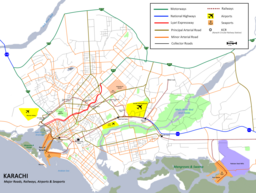
Karachi is the largest city in Pakistan and the twelfth-largest city in the world. It is the capital of the Pakistani province of Sindh. Ranked as a beta-global city, it is Pakistan's premier industrial and financial centre, with an estimated GDP of $164 billion (PPP) as of 2019. Karachi is Pakistan's most cosmopolitan city, linguistically, ethnically, and religiously diverse, as well as one of Pakistan's most secular and socially liberal cities. With its location on the Arabian Sea, Karachi serves as a transport hub, and is home to Pakistan's two largest seaports, the Port of Karachi and Port Bin Qasim, as well as Pakistan's busiest airport, the Jinnah International Airport.
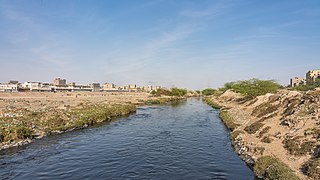
Lyari River is a small ephemeral stream that flows through the Pakistani megacity of Karachi from north east to the center and drains into the Arabian Sea at the Manora channel. It is one of the two rivers of Karachi, the other one being Malir River. The river is about 50 kilometres long. As a seasonal river it carries the collected water after the rains in the catchment area.
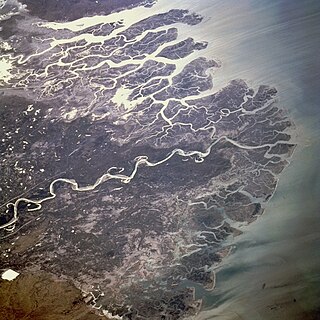
The Indus River Delta, forms where the Indus River flows into the Arabian Sea, mostly in the southern Sindh province of Pakistan with a small portion in the Kutch Region of the western tip of India. The delta covers an area of about 41,440 km2, and is approximately 210 km (130 mi) across where it meets the sea. The active part of the delta is 6,000 km2 in area (2,300 sq mi). The climate is arid, the region only receives between 25 and 50 centimetres of rainfall in a normal year. The delta is home to the largest arid mangrove forests in the world, as well as many birds, fish and the Indus dolphin.

Keamari Town lies in the southern part of the city that was named after the historic seaside municipality of Keamari. Kemari Town was formed in 2001 as part of The Local Government Ordinance 2001, and was subdivided into 11 union councils. The town system was disbanded in 2011, and Kemari Town was re-organized as part of Karachi West District in 2015.
Bhutta Village is a village in Karachi, Pakistan, which is near Keamari and the Karachi Port.

Keamari is a neighbourhood in Karachi, Pakistan. Keamari was originally an independent settlement that was built on a sandy ridge on the eastern side of Karachi Harbour.
Mithadar is one of the neighbourhoods of Saddar Town in Karachi, Sindh, Pakistan, and comprises the oldest part of Karachi that was once encircled by a wall. Mithadar and the adjacent community of Kharadar together form what is regarded as the original core of Karachi.

The Port of Karachi is one of South Asia's largest and busiest deep-water seaports, handling about 60% of the nation's cargo located in Karachi, Pakistan. It is located on the Karachi Harbour, between Kiamari, Manora, and Kakapir, and close to Karachi's main business district and several industrial areas. The geographic position of the port places it in close proximity to major shipping routes such as the Strait of Hormuz. The administration of the port is carried out by the Karachi Port Trust, which was established in 1857.
Baba and Bhit Islands are two small and densely populated islands located in the Karachi Harbour, in Karachi, Pakistan. The approximate area of the islands is 4 km² and the population is about 25,000. The islands are connected to Karachi via a ferry service to Keamari.

Debal was an ancient port located near modern Karachi, Pakistan. It is adjacent to the nearby Manora Island and was administered by Mansura, and later Thatta.

Kolachi was also a port located at modern Karachi and the old name of Karachi, Sindh, Pakistan. According to legends, it was a port developed when an old fisherwoman by the name of Mai Kolachi settled near the delta of the Indus River to start a community. One of the main Flyover (overpass) in Karachi has been named after Mai Kolachi. This settlement was also known as "Kolachi jo Goth" or "the village of the Kolachi".

The area of Karachi in Sindh, Karachi has a natural harbor and has been used as fishing port by local fisherman belonging to Sindhi tribes since [[prehistoryArchaeological excavations have uncovered a period going back to Indus valley civilization which shows the importance of the port since the Bronze Age. Port city of Banbhore was established before Christian era which served as an important trade hub in the region, the port was recorded by various names by the Greeks such as Krokola, Morontobara port, and Barbarikon, a sea port of the Indo-Greek Bactrian kingdom. and Ramya according to some Greek texts. The Arabs knew it as the port of Debal, from where Muhammad bin Qasim led his conquering force into Sindh in AD 712. Lahari Bandar or Lari Bandar succeeded Debal as a major port of the Indus it was located close to Banbhore, in modern Karachi. The first modern port city near Manora Island as established during British colonial Raj in the late 19th century.

The city of Karachi is a major transport hub of Pakistan. The Karachi port and airport are major gateways to Pakistan. The Karachi Railway stations transports the major part of Pakistan's trade with other countries.
Morontobara was an ancient name for Manora Island, located In Karachi, Pakistan.
Shams Pir is an island village near Karachi, Pakistan, along the western end of Karachi Harbour, close to Sandspit Beach and Kakapir. It is administered as part of the Karachi West district. Approximately 5,000 people now live on the island. The village is bordered by thick Mangrove forests which grow in the harbor.
Kakapir is a fishing village in Karachi Harbour, 15 kilometers to the west of Karachi, Pakistan. It is located at the western end of Sandspit Beach, near Hawke's Bay Beach. Mauripur lies to its north. Kakapir is named for a saint, whose shrine is located in the village, who reportedly was known for his brown hair. "Kaka" is the local word for brown, while "Pir" means saint. The village is reportedly about 100 years old. Residents of the village were originally from the Mithadar and Kharadar neighborhoods of Karachi, who were settled by the British in Shams Pir during the construction of the Port of Karachi. Those residents migrated further west and established Kakapir.
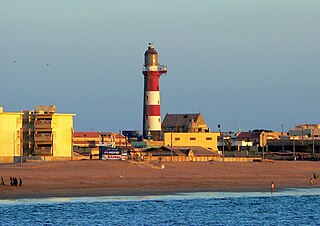
Manora or Manoro is a small peninsula that forms a protective barrier between Karachi Harbour to the north and the Arabian Sea to the south. Manora was formerly an island, but due to silting is now connected to the mainland by a 12 kilometer long natural sandbridge known as Sandspit. The entrance to Karachi was once guarded against pirate raids by the Manora Fort built in the 1790s, which was later upgraded by the British, and then the Pakistan Navy.

Karachi West District is an administrative district of Karachi Division in Sindh, Pakistan. It is located in the western part of Karachi.
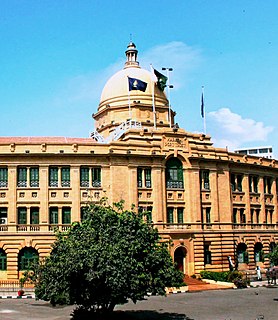
Kharadar is a neighbourhood in District South of Karachi, Pakistan. Kharadar and the adjacent communities of Mithadar and Jodia Bazaar together form what is regarded as the original core of Karachi.

The Demographic history of Karachi of Sindh, Pakistan. The city of Karachi grew from a small fishing village to a megacity in last 175 years.


